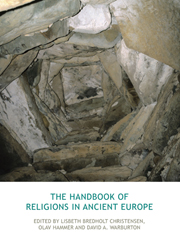Book contents
- Frontmatter
- Contents
- A note on Greek and Latin sources
- Abbreviations and short titles
- 1 Introduction
- PART I PREHISTORIC RELIGIONS
- 2 Studying prehistoric religions
- 3 Prehistoric material and religion: a personal odyssey
- 4 Francesco d'Errico and the origins of religion
- 5 On Palaeolithic religion
- 6 Ian Hodder and the Neolithic
- 7 Neolithic cult images? The testimony of figurines for Neolithic religion
- 8 Religious practices in northern Europe 4000–2000 BCE
- 9 Mythological aspects of Nordic Bronze Age religion
- 10 Religion and society in the Bronze Age
- 11 The religions of prehistoric Europe and the study of prehistoric religion
- PART II ANCIENT EUROPE IN THE HISTORICAL PERIOD
- Timeline of key dates
- Contributors
- References
- Index
6 - Ian Hodder and the Neolithic
from PART I - PREHISTORIC RELIGIONS
- Frontmatter
- Contents
- A note on Greek and Latin sources
- Abbreviations and short titles
- 1 Introduction
- PART I PREHISTORIC RELIGIONS
- 2 Studying prehistoric religions
- 3 Prehistoric material and religion: a personal odyssey
- 4 Francesco d'Errico and the origins of religion
- 5 On Palaeolithic religion
- 6 Ian Hodder and the Neolithic
- 7 Neolithic cult images? The testimony of figurines for Neolithic religion
- 8 Religious practices in northern Europe 4000–2000 BCE
- 9 Mythological aspects of Nordic Bronze Age religion
- 10 Religion and society in the Bronze Age
- 11 The religions of prehistoric Europe and the study of prehistoric religion
- PART II ANCIENT EUROPE IN THE HISTORICAL PERIOD
- Timeline of key dates
- Contributors
- References
- Index
Summary
HODDER'S PLACE IN ARCHAEOLOGY
Ian Hodder is an important archaeological voice on the cognitive thought processes of Neolithic humans, processes that can be compared to religious thought – or at least as contributing to its formation. Hodder himself has refused requests to write contributions on the specific subject of religion for more than a decade (including for this volume), and has until recently never taken a clear stand on religion as such. However, more recently (2010), a volume appeared with religion as the focus. In this section we try to identify what we consider to be the relevant aspects of his thought from previously published sources but have also added in some bits on Hodder (2010a).
Hodder studied at the Institute of Archaeology in London before going to Cambridge where he completed his studies and taught, eventually ending up in Stanford where he is now Professor. Since 1993 he has directed the resumed archaeological excavations at Çatal Höyük (an Anatolian village in the eighth–sixth millennia BCE), begun by James Mellaart in the 1960s. The finds from Çatal Höyük were neglected in the era when archaeology was dominated by approaches stressing “systems” and “functionality” whereas Mellaart had declared at the time that the discoveries were clearly incompatible with that paradigm. It was only later – with the support and influence of Hodder – that broader interpretations became acceptable.
Hodder's original base was the European Neolithic.
- Type
- Chapter
- Information
- The Handbook of Religions in Ancient Europe , pp. 45 - 52Publisher: Acumen PublishingPrint publication year: 2013



